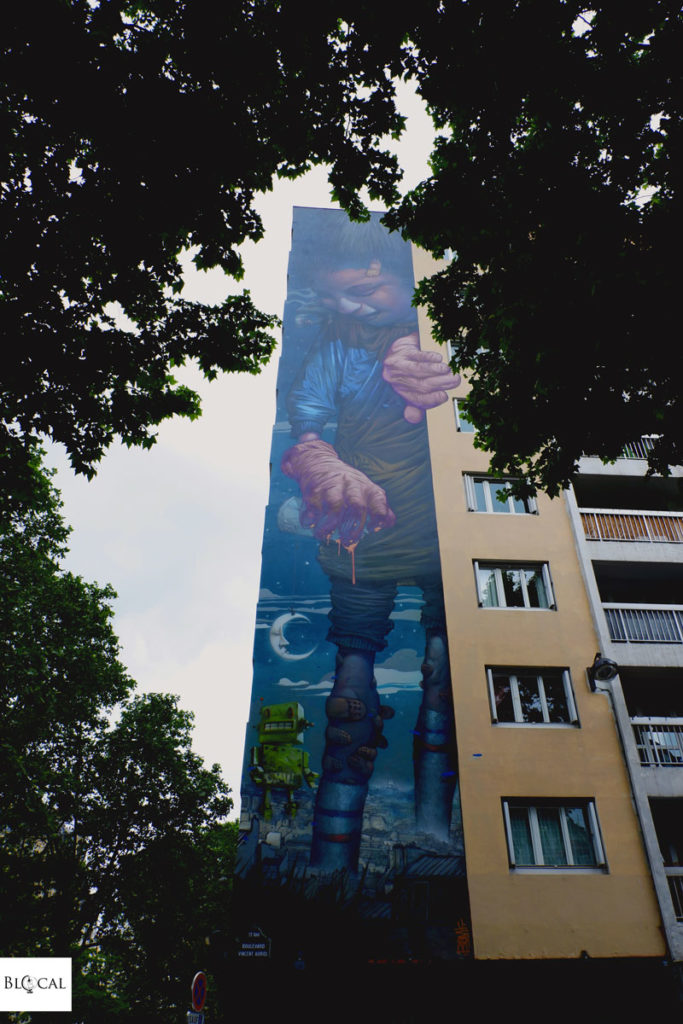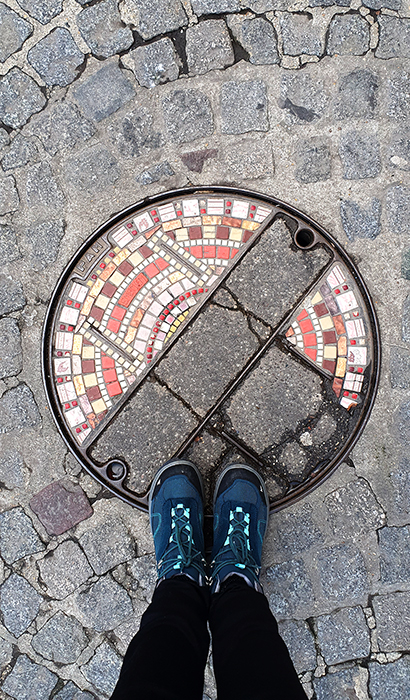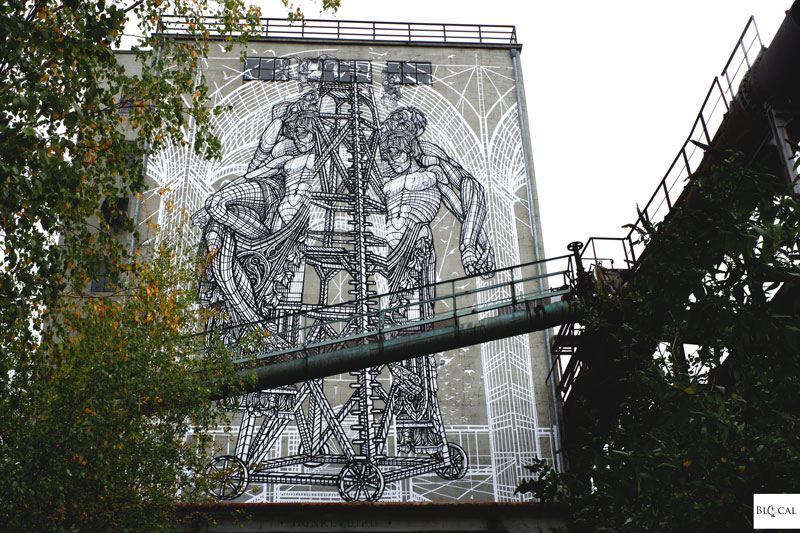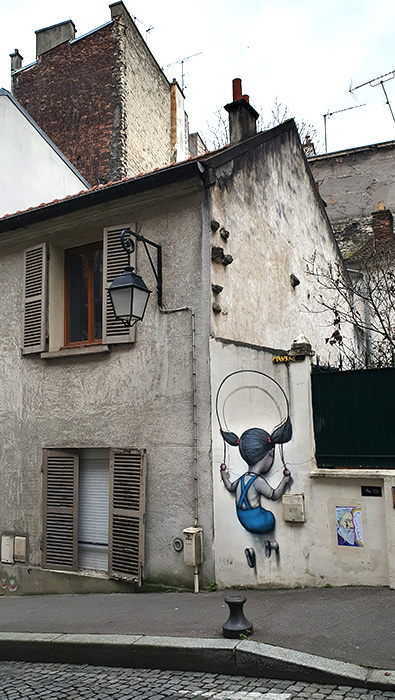France has long been home to some of the most influential and innovative street artists in the world. From pioneers like Blek Le Rat to contemporary visionaries like JR, French street artists have shaped the global urban art scene with their unique styles and thought-provoking creations. Their works, found on walls, alleys, and unexpected corners, offer a glimpse into the cultural heartbeat of French cities, particularly Paris, often regarded as the epicenter of this vibrant art form.
This deep connection between Paris and its artists is also at the core of my recently published book, As Seen on the Streets of Paris. Through interviews and collaborations with Parisian street artists, the book captures their perspectives and stories, blending them with an exploration of both iconic murals and hidden gems across the city. These voices bring authenticity to the narrative, offering a layered understanding of Paris as a dynamic canvas for street art.
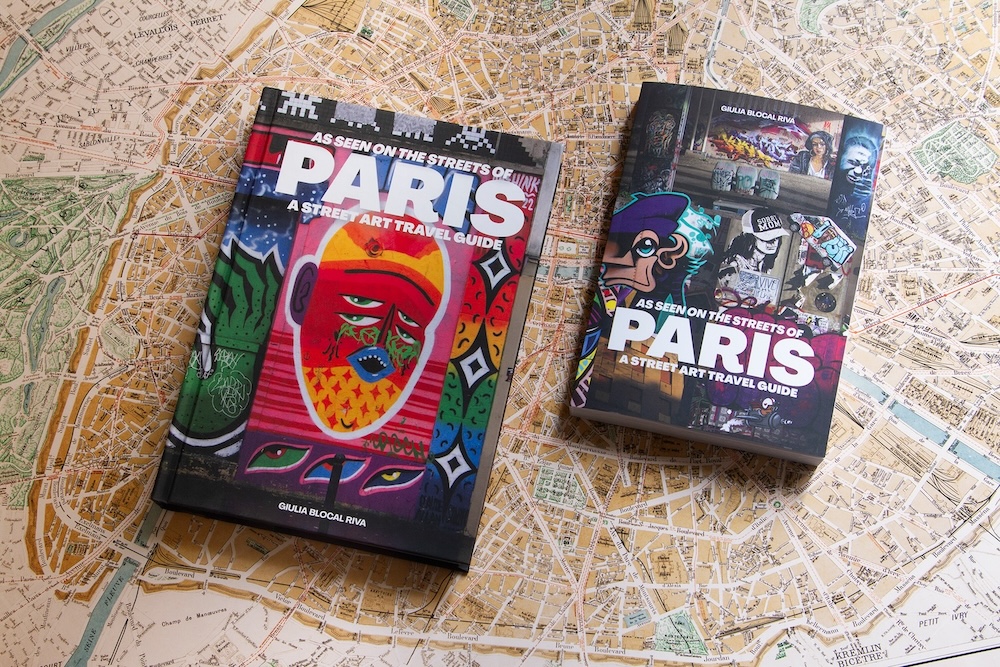

In this article, I want to celebrate the top 50 French street artists, presented in alphabetical order, introducing you to the pioneers, innovators, and emerging talents shaping French street art today. Dive into their journeys and discover how their creativity resonates far beyond the walls of Paris.
- Meet the Top French Street Artists in Street Art History
- A² Louise Michel: Political Expression Through Anarchist Street Art
- Bebar: Blending Figurative and Abstract in Vibrant Urban Murals
- Blek Le Rat: The Father of Stencil Graffiti and Urban Activism
- Bom.K: Surreal and Dark Visions in Street Art
- Brusk: Master of Drips and Multidimensional Street Creations
- C215: Poetic Stencil Portraits with Emotional Depth
- Clet Abraham: Transforming Traffic Signs into Social Commentary
- Da Cruz: Multicultural Expressions in Vibrant Street Art
- Dawal: Exploring Humanity and Machines Through Visionary Street Art
- Difuz: Graffiti Roots and Global Storytelling Murals
- Ecilop: Rebellion and Humor in Graffiti Critique
- Ella & Pitr: Monumental Giants and Playful Urban Transformations
- Eltono: Abstract Urban Compositions with Minimalist Geometry
- Ememem: Healing Urban Pavements with Colorful Tile Art
- Ernest Pignon-Ernest: Poetic Urban Installations and Memory
- Goin: Punk-Inspired Stencil Art with Subversive Edge
- Hopare: Futuristic Portraits and Humanistic Narratives
- Invader: Pixelated Mosaic Art Inspired by 8-Bit Games
- Jef Aérosol: Stencil Pioneer with Iconic Red Arrow Signature
- Jérôme Mesnager: The White Man as a Global Urban Symbol
- Jo Di Bona: Pop Graffiti Celebrating Music and Media
- JR: Large-Scale Photographic Installations Merging Art and Activism
- Kashink: Bold Faces and Gender Norms in Vibrant Murals
- Kouka: Bantu Warriors and Environmental Art with Depth
- Kraken: Urban Octopuses and the Metamorphosis of Time
- L’Atlas: Universal Calligraphy and Geometric Street Design
- Le Cyklop: Transforming Street Posts into Manga-Inspired Eyeballs
- Le Diamantaire: Diamond-Shaped Mirrors Reflecting Urban Beauty
- Lek & Sowat: Graffiti Meets Architecture in Urban Archaeology
- Levalet: Life-Size Characters Blurring Absurdity and Realism
- Mathieu Tremblin: Détournement and Hacking in Urban Art
- Maye: Surrealism and Storytelling in Meticulously Detailed Art
- Miss Van: Sensual Dolls and Feminine Expression in Urban Art
- Miss Tic: Feminist Stencils with Poetic Commentary
- M. Chat: The Yellow Grinning Cat Spreading Urban Joy
- MonkeyBird: Anthropomorphic Stencils Exploring Nature and Urbanity
- Mr. Byste: Scientific Exploration Meets Stencil Street Art
- MTO: Photorealism and Augmented Reality in Urban Art
- Murmure: Poetic Artworks Highlighting Social and Environmental Themes
- Nasty: Wildstyle Graffiti and the Evolution of Urban Art
- Némo: Black Silhouettes Bringing Poetry to Paris Streets
- Nelio: Geometric Abstraction and Layered Urban Narratives
- Oakoak: Humor and Playfulness in Urban Interventions
- OX: Contextual Billboards Redefining Urban Landscapes
- REA: 3D Organic Graffiti in Abandoned Urban Spaces
- Seth: Universal Characters Inviting Reflection and Discovery
- Tegmo: Stained Glass Installations Reflecting the Urban Landscape
- Thierry Noir: Bright Colors and Freedom on the Berlin Wall
- Vapski: Vibrant Graffiti on Parisian Van-Trucks
- Veks Van Hillik: Surreal Creatures Bridging Innocence and Darkness
- Where Can You See the Best French Street Art?
Meet the Top French Street Artists in Street Art History
A² Louise Michel: Political Expression Through Anarchist Street Art
Born in the 1970s, A² discovered graffiti as a teenager and began exploring the art form on the streets. In 2011, he adopted the pseudonym Louise Michel, a tribute to the celebrated anarchist leader of the Paris Commune, and introduced his distinctive tile installations to the city.
For A², the street serves as a canvas for political expression. His signature creations—anarchist hearts featuring an “A” within, symbolizing “Amour and Anarchie” (Love and Anarchy), the essence of A²—have become a defining feature of Paris’ urban art scene.

Bebar: Blending Figurative and Abstract in Vibrant Urban Murals
Mathias Mendez, widely recognized as BEBAR, was born in 1993 in Vitry-sur-Seine and began exploring graffiti at the age of 12. His distinctive style effortlessly merges figurative and abstract elements, capturing the dynamic spirit of Paris.
Deeply influenced by the city’s cultural vibrancy, BEBAR draws inspiration from its museums, galleries, fashion, cuisine, music, and diverse communities.

Blek Le Rat: The Father of Stencil Graffiti and Urban Activism
Blek le Rat, born Xavier Prou in 1951, is widely recognized as a pioneer of stencil graffiti and a foundational figure in the global street art movement. In 1981, he began stenciling his iconic rats across Paris, describing them as “the only free animal in the city” and a representation of urban life.

Inspired by New York City’s graffiti scene during a 1971 visit, Blek le Rat sought to adapt the art form to Paris’s unique architectural landscape. He opted for stenciling as a method that allowed for rapid execution and replication, aligning with the city’s aesthetic and his artistic vision. His early works featured small black rats running along the walls of the 14th arrondissement, marking the beginning of the transformation of Paris’s visual landscape.
In the early 1980s, Blek le Rat expanded his repertoire to include life-sized human figures, often addressing social and political issues, aiming to bring attention to global social problems.
Blek le Rat’s innovative approach has profoundly influenced contemporary street artists, including Banksy, who acknowledged, “Every time I think I’ve painted something slightly original, I find out that Blek le Rat has done it as well, only twenty years earlier.”
Bom.K: Surreal and Dark Visions in Street Art
Bom.K is a French artist known for his radically dark and surreal style, often described as a modern blend of Bosch, Escher, and Bacon. His art explores themes of human distortion, nightmarish imagery, and the violence of daily life, striking a balance between harsh realism and pervasive abstraction. With a deep sensitivity underlying his work, Bom.K creates emotionally charged pieces that are both unsettling and magnetic, offering a delicate yet morbid vision of the world around us.
A master of aerosol techniques, Bom.K’s works are characterized by exceptional precision and realism. He skillfully manipulates the human form, reshaping it into extraordinary, otherworldly creations that evoke both fascination and unease. His ability to merge opposing elements results in murals that are as haunting as they are captivating, leaving a lasting impression on viewers.
Bom.K is also a founding member of the influential Da Mental Vaporz (DMV) collective, established alongside Iso and Kan. The group later expanded to include prominent artists such as Jaws, Gris1, Brusk, Dran, Sowat, Blo, and Lek, making a significant impact on the global street art scene.
Brusk: Master of Drips and Multidimensional Street Creations
Brusk is a multifaceted artist who began his creative journey rooted in graffiti. While still inspired by his beginnings, he has since expanded his artistic horizons, exploring a wide array of techniques and media. With a foundation in old-school street writing, Brusk has consistently pushed boundaries, blending abstraction, figuration, painting, and sculpture into his practice. His work is characterized by a mastery of technical skills, which he uses to reimagine his signature themes of drip, rip, and pop culture through new textures and depths.

C215: Poetic Stencil Portraits with Emotional Depth
Born in 1973 in Bondy, a suburb of Paris, Christian Guémy—better known as C215—is a renowned stencil artist who began his artistic journey in 2006. Inspired by the Parisian stencil tradition pioneered by figures like Blek Le Rat and Jef Aerosol, his work is deeply personal, initially motivated by a desire to show his daughter Nina that she was always in his thoughts. His intricate, hand-cut stencils combine sharp details with abstract elements, establishing a signature style that stands out in contemporary urban art.
In 2008, Christian settled in Vitry-sur-Seine, a city whose cultural openness became a canvas for his artistic growth. His portraits, often of everyday individuals, transcend their subjects to evoke universal emotions, transforming the personal into the collective. C215’s small-scale street art pieces shed light on overlooked people, places, and emotions, infusing the streets with poetic depth and humanity.
Drawing inspiration from portrait photographers such as Steve McCurry, Rodolphe Simeon, and Sebastião Salgado, as well as painters like Caravaggio, C215 incorporates chiaroscuro techniques and elevates ordinary people to a near-saintly status, blending classical artistry with urban expression.

Clet Abraham: Transforming Traffic Signs into Social Commentary
After completing his studies at the École des Beaux-Arts in Rennes, Clet moved to Rome in 1990, where he worked as a restorer of antique furniture. In 2005, he relocated to Florence, establishing his own studio and immersing himself in the city’s rich artistic heritage.
Clet is renowned for his innovative approach to street art, particularly his creative modifications of traffic signs. Using removable stickers, he transforms standard road signs into thought-provoking artworks that challenge societal norms and encourage public reflection. His interventions maintain the signs’ original functions while adding a layer of artistic commentary, blending humor with social critique. His work invites passersby to engage with their surroundings in new ways, transforming everyday objects into sources of inspiration and contemplation.
Da Cruz: Multicultural Expressions in Vibrant Street Art
Da Cruz began his artistic journey at the age of 12 with tagging, eventually transitioning to street art in the early 2000s. His dynamic and colorful creations are deeply influenced by the rich tapestry of cultures he experienced growing up in the 19th Arrondissement of Paris.

Raised in a Portuguese family and surrounded by friends from diverse backgrounds, his formative years fostered a deep appreciation for cultural variety. This multicultural environment became the foundation of his artistic universe, which continues to reflect his neighborhood’s vibrant essence while celebrating global influences.

Dawal: Exploring Humanity and Machines Through Visionary Street Art
Born in 1994, Dawal shifted from a career in engineering to pursue his passion for street art in 2013, leaving behind the corporate world to explore his creative instincts.

His work delves into the complex relationship between humans and machines, illustrating how mechanical components echo the functions of our biological systems. With a surreal and visionary style, Dawal reimagines the human body as a cyborg-like entity, drawing parallels to factory assembly lines.

Difuz: Graffiti Roots and Global Storytelling Murals
Difuz began his journey in the world of street art at the young age of 13. Growing up in the 1990s, he was deeply influenced by the golden age of French rap and Japanese animation, inspirations that continue to shape his artistic vision. In 2001, Difuz co-founded the Kunfurish Crew, a dynamic independent collective that brought together graffiti writers, tattoo artists, beatmakers, and rap enthusiasts, cementing his place in the urban art scene.

A multidisciplinary artist, Difuz integrates techniques ranging from graffiti to figurative painting, producing works that are unpretentious and deeply connected to the human experience. His art reflects his vision of a world that is dynamic, interconnected, and filled with stories worth telling.
Ecilop: Rebellion and Humor in Graffiti Critique
Ecilop is a graffiti artist known for his provocative and rebellious approach to art, symbolized by his signature motif of drawing police cars backwards. This deliberate inversion serves as a critique of authority and societal norms, using humor and irony to spark reflection and challenge the status quo.
An adventurer at heart, Ecilop combines his climbing skills with his art, navigating inaccessible urban spaces and transforming the city into his personal playground. His fearless exploration of these unconventional canvases mirrors his commitment to living life on his own terms.
Ella & Pitr: Monumental Giants and Playful Urban Transformations
Ella & Pitr have been pushing the boundaries of urban art since their collaboration began in 2007. Renowned for their playful yet thought-provoking creations, their work can be found on rooftops, runways, houses, shipping containers, and even entire fields, transforming these spaces into monumental canvases. Their unique style is inspired by an eclectic mix of children’s books, comic strips, and graffiti, blending whimsical storytelling with a deeply impactful artistic vision.
One of their most iconic contributions to the street art world is their series of colossal “giants.” These massive, sleeping figures often occupy forgotten or overlooked spaces, like rooftops, where they curl up in rectangular beds painted on building tops.

Far from fantastical monsters, Ella & Pitr’s giants resemble ordinary people, creating a relatable and intimate connection with their viewers. These works, best appreciated from drones or helicopters, underscore their ability to create awe-inspiring art that embraces scale and perspective.
Eltono: Abstract Urban Compositions with Minimalist Geometry
Eltono is a contemporary artist whose creative journey began with graffiti in the 1990s. Over time, his work evolved from traditional graffiti to abstract art, characterized by bold lines, geometric forms, and vibrant color palettes. His work is deeply rooted in the exploration of urban environments and the interaction between art and the public.
Eltono’s abstract compositions often emerge from improvisation, influenced by the architectural and social context of the spaces he inhabits. His use of clean, geometric shapes reflects a minimalist approach while maintaining a playful and dynamic spirit.
Ememem: Healing Urban Pavements with Colorful Tile Art
Ememem takes a unique approach to street art, focusing on roads and pavements instead of building facades or walls. Through vibrant tile interventions, he invites us to (re)discover urban spaces in a playful and thoughtful way.
Using colorful ceramic tiles and grout, Ememem ‘repairs’ cracks and potholes in streets and sidewalks, creating intricate mini mosaics that breathe new life into neglected areas. Each tile is carefully pre-cut and cemented into place, blending craftsmanship with urban intervention. His work not only beautifies the cityscape but also reimagines damage and decay as opportunities for artistic expression.

Ernest Pignon-Ernest: Poetic Urban Installations and Memory
Ernest Pignon-Ernest is a pioneering figure in the world of urban art, celebrated for his profound and poetic interventions in public spaces. Beginning his artistic journey in the 1960s with stencil and screen-printing techniques, he was one of the first to bring ephemeral art into the streets, transforming urban environments into both canvas and subject. His work explores the intersections of memory, events, and myths, embedding powerful, symbolic imagery into the very fabric of the cities he inhabits.
Pignon-Ernest’s practice is as much about the spaces he engages with as it is about the images he creates. By carefully integrating his work into the physical and historical context of a site, he challenges viewers to reflect on its cultural and social significance. His art is both political and poetic, addressing themes of history, humanity, and collective memory.
Goin: Punk-Inspired Stencil Art with Subversive Edge
Goin, a French stencil artist with a foundation in punk ethos, channels the raw energy and rebellious spirit of his artistic roots into provocative works that challenge societal norms. Goin’s art combines striking graphics and bold typography with an unrelenting chaotic edge, creating visually arresting pieces that are as subversive as they are thought-provoking. His militant-powered images are laced with sharp commentary, using the prism of graphic art to deconstruct and critique the status quo.
In a constant state of evolution, Goin’s creations push boundaries, challenging audiences to confront the chaotic beauty and critical messages embedded in his work. His art is not just an expression—it’s an experience, alive with the spirit of rebellion and the urgency of modern critique.
Hopare: Futuristic Portraits and Humanistic Narratives
Known for his unmistakable style, Hopare‘s portraits, whether on walls, canvases, tapestries, or in bronze sculptures, captivate viewers at first glance. His creations, defined by precise vectorial lines, blend futurism with humanistic themes, creating a signature aesthetic that resonates deeply with his audience.

His murals often serve as a tribute to forgotten figures and overlooked narratives, bringing humanity and history to the forefront. Hopare’s dedication to pushing the limits of his craft keeps his audience intrigued and eager for what comes next.
Invader: Pixelated Mosaic Art Inspired by 8-Bit Games
Invader is a pioneering French street artist whose work reimagines the pixelated aesthetics of 1980s 8-bit video games, particularly the arcade classic Space Invaders. His signature creations are crafted from mosaic tiles, meticulously arranged to depict video game characters and objects, transforming the nostalgic graphics of the digital era into a unique and tangible art form. Unlike traditional street art, which is often painted or pasted, Invader’s mosaics are cemented into place, blending permanence with urban subversion.
Building on his video game-inspired roots, Invader has gamified his art practice through an app called FlashInvaders. This innovative platform allows users to hunt for his mosaics worldwide, earning points based on the size, complexity, and location of each installation—mirroring the rules of video game and graffiti cultures. Through this interactive approach, Invader has created a global treasure hunt that extends his playful, participatory vision beyond the streets.
Jef Aérosol: Stencil Pioneer with Iconic Red Arrow Signature
Jef Aérosol, born Jean-François Perroy in 1957 in Nantes, France, is a pioneer of the stencil art movement and one of its most influential figures. His career began in 1982 with his first stencil in Tours, marking the start of a journey that would transform urban landscapes around the world. Aérosol’s signature style combines striking monochromatic portraits with his iconic red arrow, a visual motif that directs attention and adds a distinct identity to his work.
Known for blending personal and universal themes, Aérosol’s portraits capture cultural icons like Jimi Hendrix, Bob Dylan, and anonymous figures, reflecting his deep engagement with both pop culture and human emotion. His work often bridges the gap between the public and the personal, offering viewers an intimate connection to his subjects while challenging them to reconsider their surroundings.
Jérôme Mesnager: The White Man as a Global Urban Symbol
Jérôme Mesnager is a pioneering figure in French street art. He is best known for creating the “Homme en blanc” (“White Man”) in 1983—a white silhouette symbolizing light, strength, and peace. This emblematic figure has been painted worldwide, from the streets of Paris to the Great Wall of China. The “Homme en blanc” has become a significant symbol in urban art, representing a blend of poetic expression and social commentary.
Jo Di Bona: Pop Graffiti Celebrating Music and Media
Jo Di Bona seamlessly blends pop culture, music, and street art. Growing up in a working-class neighborhood of Paris in the late 1980s, his first encounter with hip-hop culture ignited his creative journey. Immersed in a dynamic environment filled with graffiti, skateboarding, and rap music, he found his artistic voice early on. As a self-taught artist, Jo Di Bona quickly developed his unique visual style, which he calls “Pop Graffiti.” This vibrant approach merges urban aesthetics with references to pop icons, creating works that are as dynamic as they are reflective of his influences.

His art celebrates the intersections of music, media, and visual storytelling, all while emphasizing a dialogue with his audience. Jo Di Bona’s artistic journey has been anything but linear. After a 12-year stint as a musician, he returned to painting with a renewed focus. He credits his time in music for teaching him discipline, teamwork, and a strong sense of composition—qualities that now define his artistic practice.
JR: Large-Scale Photographic Installations Merging Art and Activism
JR, born Jean-René in 1983, in Paris, is a renowned French contemporary artist celebrated for his large-scale photographic installations in public spaces. Describing himself as a “photograffeur”—a blend of photographer and graffiti artist—he transforms urban environments into expansive galleries, making art accessible to a broad audience.

His artistic journey began in 2001 when he discovered a camera in the Paris Métro, leading him to document and paste images of his graffiti endeavors across the city. This fusion of photography and street art laid the groundwork for his signature style.
- Explore JR’s diverse projects that seamlessly merge art with activism in my article “JR, changing the world one artwork at at time”
Kashink: Bold Faces and Gender Norms in Vibrant Murals
Born in 1981, Kashink (they / them) has been a dynamic force in the street art world since 2001. Starting with small sticker campaigns, Kashink transitioned to using spray cans in 2007, marking the beginning of large-scale murals that now define their vibrant artistic style. Inspired by traditional masks from around the world, Kashink’s signature works feature bold, brightly colored faces with distinct four-eyed designs—each pair of eyes conveying a unique emotional narrative.

Kashink’s art is as much about challenging societal norms as it is about aesthetic expression. Through their murals, Kashink celebrates diversity and embraces themes of identity, gender, and self-expression. Their creative journey has taken them across the globe, collaborating with street artists and painting murals that provoke thought and spark conversations in communities worldwide.

Kouka: Bantu Warriors and Environmental Art with Depth
Born in 1981 into a family steeped in creativity, Kouka was exposed to both African and Western art from an early age, shaping his unique artistic vision. His journey began in 1995 with tagging, a foundation that evolved into figurative street art by 2006. A transformative trip to Congo-Brazzaville reconnected him with the Bantu tradition, inspiring his iconic Bantu Warrior series in 2008. This striking figure, embodying both strength and dignity, has since become a global symbol, gracing walls worldwide.
Kouka’s artistic evolution extends beyond the Bantu Warrior. His work now explores themes of nature and the wildness of untamed jungles, blending figurative elements with expressionistic flair. In recent years, his focus has shifted to environmental concerns, prompting him to adopt a minimalist palette and sustainable materials.

Kraken: Urban Octopuses and the Metamorphosis of Time
Kraken started painting on the streets in 2012, using public spaces to counteract the isolation of studio work. His iconic giant octopuses now adorn facades across Paris, seamlessly blending with the city’s urban environment and rooting his art in its surroundings. A keen observer of everyday life, Kraken’s recent works delve into themes of time and metamorphosis. From sprawling murals to intricate sculptures, Kraken’s work captures the complexity of human existence and the stories hidden within the passage of time.
L’Atlas: Universal Calligraphy and Geometric Street Design
Born in Paris in 1978, L’Atlas is a prominent French street artist who began his career in the early 1990s as a graffiti writer. Fascinated by the history of writing, he studied calligraphy in various countries, developing his own unique typography. His work often transforms public spaces by blending written language with abstract calligraphic forms.

Drawing inspiration from urban architecture, archaeology, mythology, and astronomy, L’Atlas strives to create a universal language—a writing system accessible to all, where form takes precedence over content. Cities frequently appear in his work as geometric, labyrinth-like designs that feel both primitive and modern, brought to life through his characteristic use of black and white.
Le Cyklop: Transforming Street Posts into Manga-Inspired Eyeballs
Born in 1968, Olivier D’Hondt, better known as Le Cyklop, began painting in the streets during his teenage years. In 2007, he launched his signature Cyklop concept, transforming ordinary street posts into whimsical works of art. By adapting to their cylindrical form, Le Cyklop turns these mundane urban objects into vibrant “manga-style eyeballs” or L’égo, injecting surprise and creativity into public spaces.
His work aims to captivate commuters, breaking the monotony of daily routines with playful, anthropomorphic designs. Drawing inspiration from toys, comic books, animal lore, and Greek mythology, Le Cyklop merges fantasy with modern cultural references. Playful yet thought-provoking, his creations reimagine the cityscape with a touch of humor and imagination.

Le Diamantaire: Diamond-Shaped Mirrors Reflecting Urban Beauty
Le Diamantaire is a Paris-based multidisciplinary street artist renowned for his distinctive diamond-shaped mirror mosaics that adorn urban landscapes worldwide. Transforming discarded mirrors into public art that captivates passersby, his signature diamond mosaics reflect light and color, creating dynamic interactions with their surroundings. His work not only beautifies urban environments but also challenges perceptions of value and luxury by repurposing abandoned materials into symbols of opulence.
Lek & Sowat: Graffiti Meets Architecture in Urban Archaeology
Lek & Sowat are a groundbreaking artist duo whose work bridges the worlds of street art, architecture, and archaeology. Their collaboration began in 2010, bringing together Lek’s expertise in abstract graffiti and Sowat’s affinity for architectural forms.

Drawing inspiration from their urban surroundings, they have developed a signature style that merges abstract forms with architectural elements, redefining the boundaries of graffiti within contemporary art. Their practice is rooted in experimentation and a deep appreciation for the layers of history found in the urban landscape.
Levalet: Life-Size Characters Blurring Absurdity and Realism
Levalet first emerged as a street artist in 2012, and his unique style quickly gained recognition. By blending the absurd with the familiar, he introduces gaps in perception that surprise and engage his audience. His life-size, ink-based characters have become a hallmark of his work, sneaking into urban environments and interacting with their surroundings in unexpected ways. These figures, often imbued with a touch of irony or subtle poetry, are carefully positioned to disrupt the normal use of windows, doors, staircases, and other urban elements, creating a seamless blend between art and context.
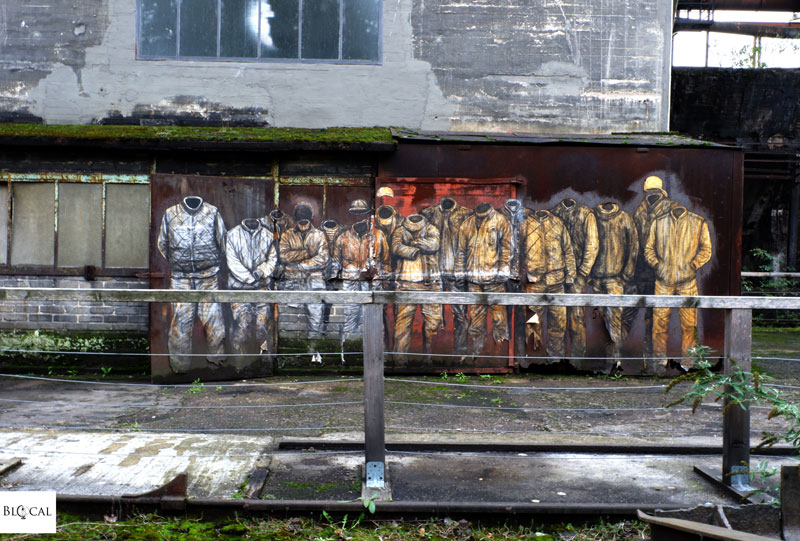
With a background in theater and video installation, Levalet brings a strong narrative depth to his work. His art often blurs the lines between realism and detachment, with characters that exist on the edge of storytelling and absurdity. Whether portraying situational humor or a quiet moment of reflection, his creations challenge viewers to rethink their surroundings.
Mathieu Tremblin: Détournement and Hacking in Urban Art
Mathieu Tremblin is a French street artist known for his innovative approach to urban spaces, blending graffiti with creative interventions like repurposing street furniture. His work often highlights the “misuse” of urban elements, drawing inspiration from the cultures of détournement and hacking. With a critical yet ironic lens, Tremblin examines city life and its regulatory systems, challenging conventional perspectives on urban environments.

Tremblin’s artistic practice extends to situational urban interventions, walking explorations, creating tools, and repurposing objects. He meticulously documents these experiments through narratives, publications, installations, photographs, and videos, making his work both dynamic and multidimensional.
Maye: Surrealism and Storytelling in Meticulously Detailed Art
Maye is an artist whose creative journey began in the streets of Montpellier, where he discovered graffiti at the age of 13. Growing up, he joined the SPN Crew, honing his craft before transitioning to canvases and developing a distinct style that merges figuration with surrealism. Maye’s delicate and meticulously detailed works reflect a poetic approach to storytelling, blending realism with dreamlike dimensions.

His work goes beyond the aesthetic, inviting viewers to delve into the narrative dimension of his pieces. His slender, elongated figures interact seamlessly with their environments, creating compositions that are both dynamic and contemplative. These elements combine to tell a story, bridging the gap between art and poetry.
Miss Van: Sensual Dolls and Feminine Expression in Urban Art
Born in 1973 in Toulouse, Vanessa Alice Bensimon, professionally known as Miss Van, is a pioneering graffiti and street artist. She began painting on the streets of her hometown at the age of 18, becoming one of the first women to make a significant impact in the street art scene.
Miss Van is renowned for her distinctive “poupées” (dolls)—sensual, sloe-eyed female figures that exude a blend of innocence and eroticism. These characters are often depicted wearing under-bust corsets, petticoats, tutus, and occasionally animal masks, drawing inspiration from burlesque aesthetics.
Miss Tic: Feminist Stencils with Poetic Commentary
Miss Tic was a pioneering French street artist and poet. She was renowned for her distinctive stencils of dark-haired women, often accompanied by poetic, thought-provoking phrases, which adorned the streets of Paris. Her work seamlessly blended visual art with literary expression, making her a significant figure in the urban art scene.
In the early 1980s, Miss.Tic spent time in California, where she was influenced by the burgeoning graffiti culture. Upon returning to Paris, she began creating her iconic stencils in 1985, focusing on areas like Ménilmontant, Montmartre, Le Marais, Montorgueil, and La Butte-aux-Cailles. Her art often featured self-portraits combined with witty wordplay, reflecting her personal experiences and feminist views.
M. Chat: The Yellow Grinning Cat Spreading Urban Joy
Famous for his iconic yellow grinning cat, Thoma Vuille, widely recognized as Monsieur Chat, began his street art journey in Orléans in 1997. Often depicted in motion and radiating joy, the playful feline has come to represent happiness within the urban landscape.
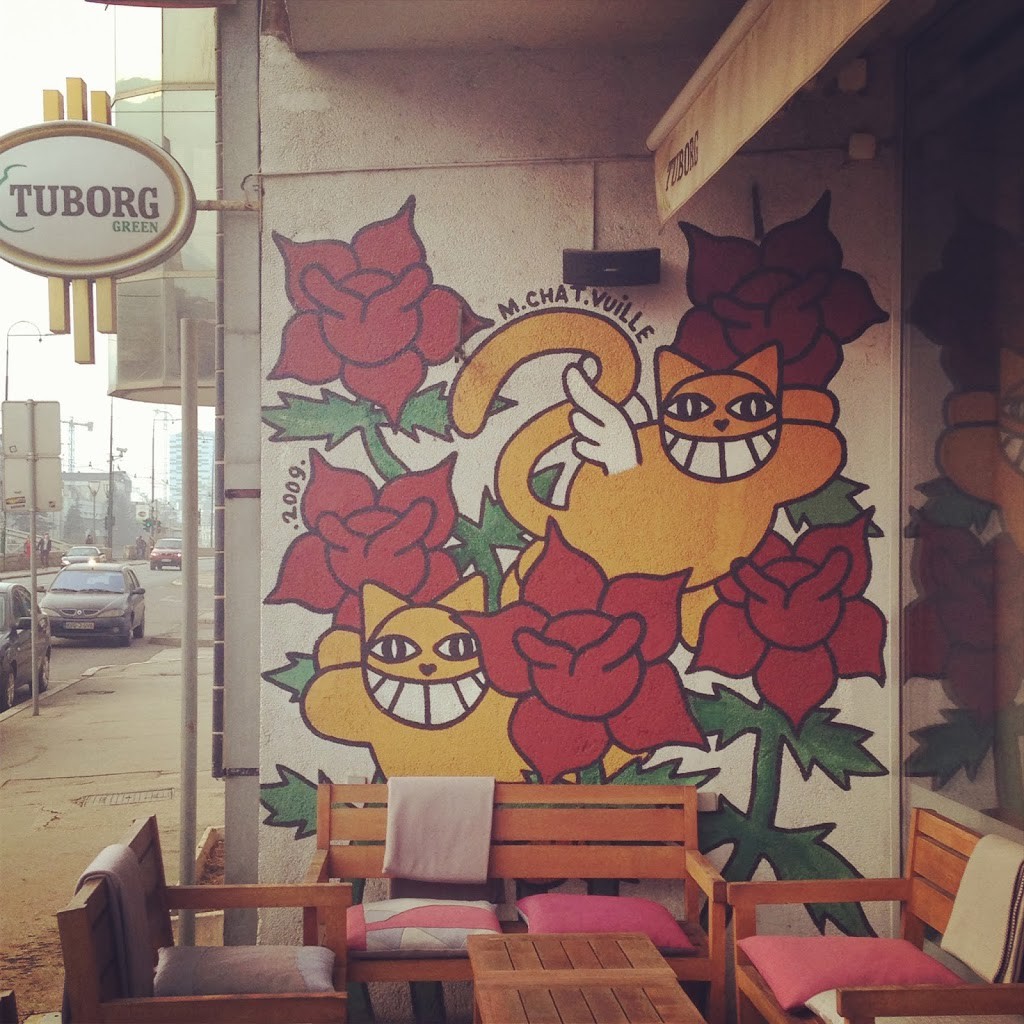
Its simple yet expressive design and enigmatic smile have cemented Monsieur Chat’s place as a pioneer among a new wave of street artists. These artists brought their work into public spaces, breaking ground in a domain previously dominated by traditional graffiti.

MonkeyBird: Anthropomorphic Stencils Exploring Nature and Urbanity
MonkeyBird is a French artist duo renowned for their intricate street art that blends symbolic anthropomorphism with architectural elements. Their work often features detailed stencils of animals intertwined with geometric patterns and motifs inspired by Gothic and industrial architecture. This unique fusion creates visually compelling pieces that explore the relationship between nature and urban environments.
The duo has gained international recognition, with their art adorning walls in various cities worldwide. Their meticulous technique and thought-provoking themes have made them prominent figures in contemporary street art. Through their creations, MonkeyBird invites viewers to reflect on the coexistence of the natural world and human-made structures, offering a poetic commentary on modern society.
Mr. Byste: Scientific Exploration Meets Stencil Street Art
Born in 1989, Mr. Byste began his journey as an urban artist in 2017 by venturing into the catacombs of Paris to distribute free, collectible art leaflets, which doubled as clues for treasure hunts.

In 2022, influenced by the movement studies of Muybridge and Marey, Mr. Byste incorporated stop motion techniques into his stencil work, animating the skeletons of his “Schrödinger’s animals.” His style blends art and science, drawing from Ernst Haeckel’s aesthetic and his own interest in phylogenetics.

MTO: Photorealism and Augmented Reality in Urban Art
MTO, born Mateo, is a French artist celebrated for his large-scale, photorealistic portraits rendered primarily in grayscale. Initially inspired by Barcelona’s vibrant graffiti scene, MTO began his journey in street art before moving to Berlin in 2006, where he spent seven years establishing himself as a master of photorealistic painting. His works often depict iconic figures from music and film, characterized by their meticulous detail and striking visual impact.
Murmure: Poetic Artworks Highlighting Social and Environmental Themes
Paul Ressencourt and Simon Roché, who met during their Fine Arts studies, bring together their complementary backgrounds—one in graphic and urban arts, the other in arts and technique—to form a dynamic creative duo. United by a shared passion for drawing and street art, they have been collaborating since 2010, adorning city walls with murals, stencils, and posters. Working under the name Murmure, they use their art to explore themes such as childhood, homelessness, consumer society, technology, and the environment, delivering their message with a blend of playfulness and poetry.
Murmure’s creative process begins in the studio, where their collaborative efforts take shape. Using graphite pencils, they achieve remarkable depth and realism, crafting detailed drawings that serve as the foundation for their street-based works.
- Come with me on a paste-up mission in the streets of Paris with Murmure duo:
Nasty: Wildstyle Graffiti and the Evolution of Urban Art
Nasty is a French artist whose work has redefined the perception of graffiti, elevating it from an act of vandalism to a recognized art form. Active since the 1980s, he has built a reputation for his bold lettering and his ability to challenge societal norms through his art. While his work often avoids direct political commentary, it remains deeply connected to the social fabric and urban environments in which it exists.

Inspired by the aesthetics of wildstyle graffiti, Nasty’s practice merges his roots in street art with a desire to educate and provoke thought. His works reflect his ability to balance the raw energy of graffiti with a polished, thoughtful approach, engaging both underground audiences and the broader public.
Némo: Black Silhouettes Bringing Poetry to Paris Streets
Serge Faurie, known artistically as Némo, was a pioneering French street artist born in 1947. Némo was renowned for his distinctive black silhouette of a man in a raincoat and hat, often accompanied by elements like balloons, umbrellas, and cats. His works graced the walls of Parisian neighborhoods such as Belleville and Ménilmontant, transforming neglected urban spaces into poetic scenes.
An informatics professional by trade, Némo began his artistic journey in the early 1980s. He was instrumental in shifting street art from mere urban protest to a more poetic expression, influencing artists like Banksy.
Nelio: Geometric Abstraction and Layered Urban Narratives
Nelio, born in France in 1982, is a self-taught artist who began his journey in the late 1990s with graffiti. Over time, he has developed a distinctive style that merges symbols, letters, landscapes, and geometric forms, creating intricate compositions that blur the lines between representation and abstraction.
His work is characterized by vibrant colors and geometric shapes, often resulting in complex, layered visuals that engage viewers in a unique perceptual experience. Nelio’s art has been featured in numerous public spaces across Europe, reflecting his continuous exploration of new forms and techniques.
Oakoak: Humor and Playfulness in Urban Interventions
Oakoak, a French street artist from Saint-Étienne, has been transforming urban landscapes since 2006 with his inventive and humorous interventions. By cleverly integrating his art into existing urban elements—such as cracks, street fixtures, and architectural features—he brings mundane cityscapes to life, often infusing them with characters from pop culture and comic books.

His work aims to surprise and delight pedestrians, encouraging them to see their surroundings in a new, more whimsical light. Oakoak’s approach involves identifying imperfections or unique aspects of urban environments and creatively reimagining them. This method not only showcases his keen eye for detail but also reflects his desire to add poetry and playfulness to everyday settings.

OX: Contextual Billboards Redefining Urban Landscapes
Hailing from Paris, OX is often regarded as a pioneer of urban art. His true focus lies in playing with context, drawing inspiration from a wide variety of forms and sources. A hallmark of OX’s practice is his unauthorized posters. Since his time with the eccentric and spontaneous Frères Ripoulin collective (1984–1987), he has transformed countless 4×3 billboards.

Following a meticulous process of scouting locations and painting posters in his studio, OX extends beyond the advertising frame to interact with the surrounding architecture, vegetation, and urban infrastructure. His posters merge abstraction, figuration, advertising, and signage to confront the urban environment, shifting between integration and disruption. The final act—a photograph of the intervention—captures the work as a deconstructed landscape, stripped of urban clutter like cars or passers-by. This pairing of painting and photography reimagines the landscape genre, forging a dynamic dialogue between site and non-site.
REA: 3D Organic Graffiti in Abandoned Urban Spaces
Born in the suburbs of Paris in 1978, REA is a post-graffiti artist who has been active on the streets since 2000. His iconic 3D Organic Graffiti can be found in numerous abandoned places around Paris and beyond, as well as in many Parisian halls of fame.

Seth: Universal Characters Inviting Reflection and Discovery
Born in Paris in 1972, Julien Malland, widely known as Seth, developed his craft at the National School of Decorative Arts in Paris. Active in the Parisian graffiti scene during the 1990s, he represented crews such as M/CMP, VMD, and 90DBC. His early works combined characters with graffiti elements, including lettering and backgrounds, often found on vacant lots, abandoned buildings, and public walls.
Seth’s distinctive characters are deeply influenced by his travels and the diverse individuals he encountered worldwide. Over time, he simplified these figures, eventually omitting their faces to encourage universal identification and emphasize their essence over specific identity. This approach invites viewers to reflect on broader themes, fostering a deeper connection with the artwork. Seth’s creations serve as portals to new worlds, leaving it to the observer to decide whether to venture into the stories they evoke.

Tegmo: Stained Glass Installations Reflecting the Urban Landscape
Born in 1985, Tegmo entered the street art scene in 2019 with his innovative installations. He is best known for his three-dimensional stained glass creations, which are uniquely crafted to reflect the environment around them rather than the viewer’s image.
Abstract in design, his works often feature a recurring triangle motif and occasionally serve as artistic planters, seamlessly merging art with nature.

Thierry Noir: Bright Colors and Freedom on the Berlin Wall
Born in 1958 in Lyon, Thierry Noir is a pioneering street artist renowned for being the first to paint the Berlin Wall in the 1980s. After moving to West Berlin in 1982, he began transforming the Wall’s oppressive presence with his brightly colored, cartoon-like figures, which have since become iconic symbols of freedom and resistance. Noir’s work not only challenged the political status quo but also laid the groundwork for the contemporary street art movement.
Vapski: Vibrant Graffiti on Parisian Van-Trucks
Vapski, a member of the MDC crew, is renowned for his vibrant graffiti adorning vans across the city. Originally from Bulgaria, Vapski has been painting colourful pieces on Paris’ van-trucks since 2000.

Veks Van Hillik: Surreal Creatures Bridging Innocence and Darkness
Born in 1988 in a small village in southwestern France, Veks Van Hillik is a French artist celebrated for his surreal and dreamlike creations. Inspired by the natural beauty of his rural upbringing, he drew early influence from the local flora and fauna. His artistic style is shaped by classical masters such as Gustave Doré, Ingres, Caravaggio, Dalí, and Breton, which he seamlessly merges with pop culture elements like video games, comics, street art, and tattoo artistry. This distinctive blend places his work firmly within the Lowbrow and Pop Surrealist movements.
Since his first exhibition in Toulouse in 2010, Van Hillik has gained recognition for his surrealistic style, often portraying fantastical creatures and hybrid beings. His works invite viewers into a world where innocence meets darkness, capturing the imagination through a unique interplay of whimsy and the uncanny.
Where Can You See the Best French Street Art?
France, often celebrated as the cradle of modern street art, has a rich tradition of turning public spaces into platforms for artistic expressions. From the towering murals of Grenoble to the colorful streets of Marseille, the country is a treasure trove of urban art destinations, showcasing works by both renowned French and international street artists.
At the heart of this thriving scene is, ça va sans dire, Paris, the ultimate destination for street art enthusiasts. The city’s walls are alive with an eclectic mix of styles and themes, created by artists from around the globe as well as local talent, making Paris an essential stop for anyone passionate about urban art.
Paris offers an abundance of street art gems—both iconic and hidden—that inspired me to dedicate a 278-page book to the city’s dynamic street art culture. Blending the depth of a travel guide with the beauty of an art photography collection, this book uncovers why Paris remains a cornerstone of the European urban art movement.




